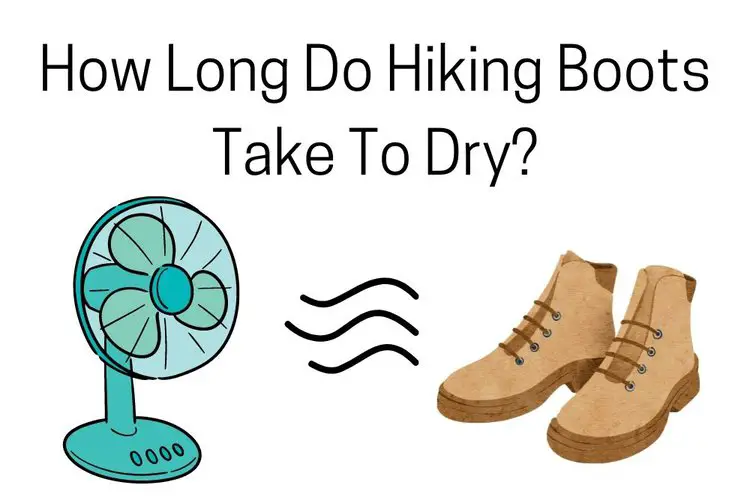Ask any hiker and they will probably tell you that one of the worst feelings is getting their hiking boots wet or dirty. When it is dirty, you will have to wash them, but drying afterward can be a tough job.
Depending on the material of the hiking boot as well as your drying technique, it may take you from a few hours to days to properly dry your hiking boots. Boots made of synthetic materials will likely dry faster than boots made from leather.
Getting your boots wet or dirty is almost unavoidable when you hike swampy trails or plan your hike during the wet season. Does that mean that you should restrict your fun simply because drying hiking boots is difficult? Definitely not!
Nevertheless, hiking in wet boots is a bad practice that everyone should avoid at all costs. Firstly, it is usually uncomfortable to walk in a wet boot that drips liquid and leaves stains wherever you go.
Secondly, hiking in wet boots predisposes you to frostbites if you hike during the winter or cold seasons. Getting your boots wet should never be the end of your hiking expedition.
In addition to the aforementioned consequences, not drying your boots properly will cause them to stink over time—and your feet will pick up this stink if you walk in them. Also, a wet pair of boots is an invitation to molds that will further degrade the fabric of the boots.
However, a wet pair of boots should never be the reason why you should change your hiking schedule. Today we are going to tell you how long it takes hiking boots to dry—depending on the technique you use.
Contents
How long do hiking boots take to dry?
Without any form of intervention, when you wash your boots and keep them in a room to dry, it will take over 48 hours to get the job done. Even after that, leather boots will still feel moist. This is long enough to invite molds on them.
Knowing the different methods used for drying hiking boots is not enough. In addition to that, you need to know how long each of the techniques will take to dry your boots.
This is a handy skill that every hiker should have because you can never tell when the weather will go haywire and release a heavy downpour or when the trail you once knew will be cut off by a pool of mud or water.
Even when none of that happens, you still need to give your hiking boots a good wash every now and then to maintain their aesthetics. You will think washing is hard until you try to dry your boots afterward.
We strongly believe that the majority of those asking how long hiking boots take to dry are those that are concerned about drying their boots on the trail. Now, let us take a look at different drying techniques and how long they will take to dry your boots, beginning with drying methods for those on the trail.
1. Sun-drying
Placing your hiking boots directly under the sun may not be a good idea, especially for leather hiking boots. However, if your boots happen to get wet on the trail you will be left with little or no other alternative than to make peace with the sun.
Before hanging your boots out in the sun to dry, it is always important to take out the insoles (where possible) and laces, turn the boots upside down and give them a good shake to get out as much moisture as possible.
This will allow it to dry faster compared to when you have a pool of water in the boots. Remember to hang your socks separately too. Wearing wet socks with boots will counteract any progress you have made with the drying.
On a day with a clear sky, you should achieve a decent level of dryness in 3 to 5 hours depending on the intensity of the sun. On a cloudy day, it may take longer.
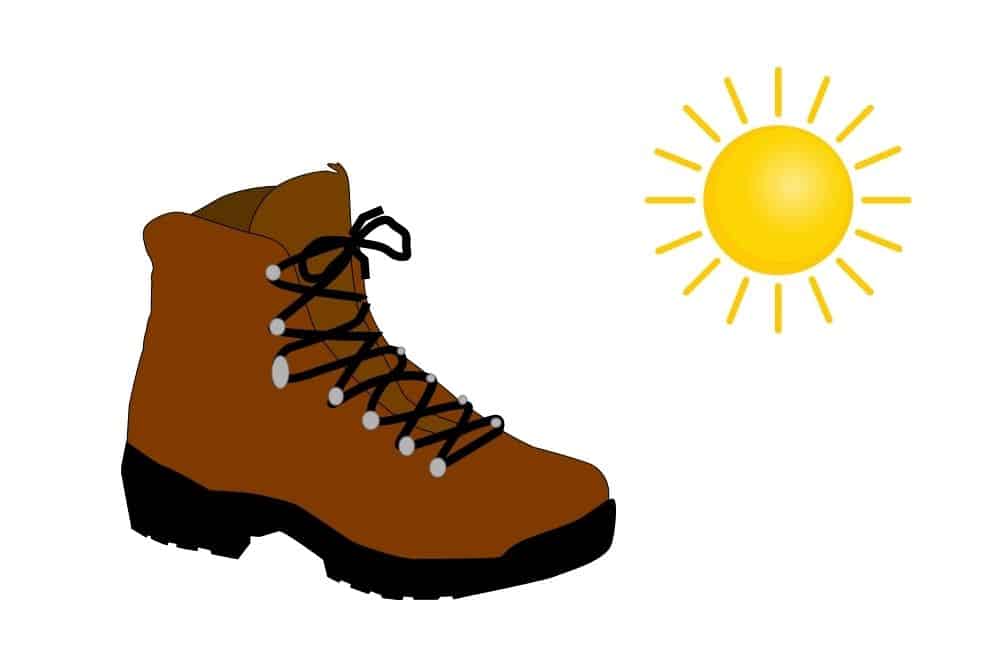
2. Use a campfire
Another popular technique hikers use to dry their boots is keeping them around the campfire. As you already know, keeping boots close to the fire is a terrible idea because the heat from the flame can melt the glue holding the soles or melt any rubber component of the boots.
Therefore, it is important to keep the pair of boots a safe distance from the fire. Due to the delicate nature of this process, it will take a longer time to dry—we are talking 10 to 12 hours.
If you try to speed up the drying process, you may end up ruining your boots. Also, we strongly advise that you approach this technique with extreme caution. Only use them when there is no other alternative.
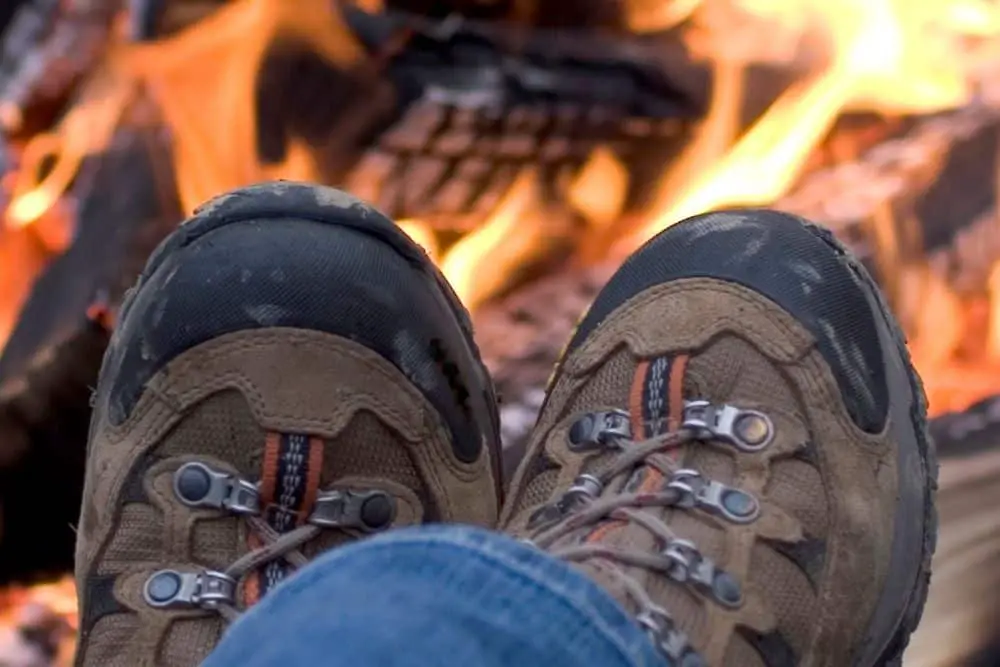
3. Hot rocks
If you hike volcanic craters or an area with a dormant volcano, you will easily find hot rocks. However, you can also make rocks hot by exposing them to heat like fire or the sun.
This is a good alternative for those that are scared of keeping their hiking boots directly under the sun to dry. The main problem with this technique is that it may be hard to properly regulate the temperature of the rocks.
Throwing really hot rocks into your boots may leave burn marks on them. Worse still is the fact that you can burn your hands while trying to pick up the rocks. An alternative is to put the rocks into your socks before stuffing them into your boots.
It is hard to achieve perfect dryness with this method and you will have to remove and reheat or change the rocks (if you have many of them) once they become cold. The process of reheating and replacing the rocks will take you about 10 hours to get the boots to manageable dryness.
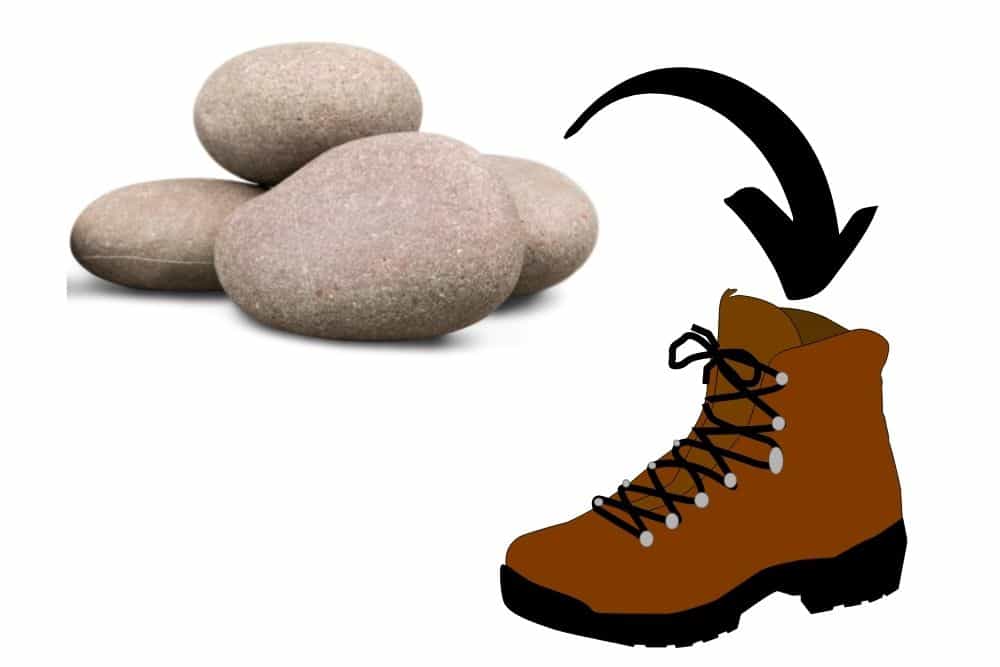
4. Stuff them up
Stuffing boots with materials is a popular drying technique that every hiker should know already. If you are at home and have access to toilet papers, silica gel sachets, blotting paper, newspapers, rice in cotton bags, or rags, you can stuff them inside the boots to help wick out moisture.
When you are on the trail, it is a different ball game because you may not have access to these materials. Nevertheless, you can stuff your boots with dry leaves or grass to achieve the same effect.
For more effective and faster drying, you have to take out the stuffing material every time they get soggy and replace them with new ones. We advise you to change them every 1 or 2 hours. This is a slow drying process that usually lasts all through the night or 10 to 12 hours.
The outcome will depend on the level of wetness of the boots in the first place, the material of the boot, the type of stuffing material, and how often you change the wicking material.
With this method, you can make the boots to be less soggy but will still feel cold to wear. You may resort to other drying techniques if you want the boots to be warm to the feet. Nevertheless, in 24 hours, most of the moisture should be out by stuffing alone.
The most important advantage of this method and other slow-drying methods is that they allow the boots to dry naturally and will not harm the material of the boots. Slow-drying techniques usually help to preserve the lifespan of your boots.
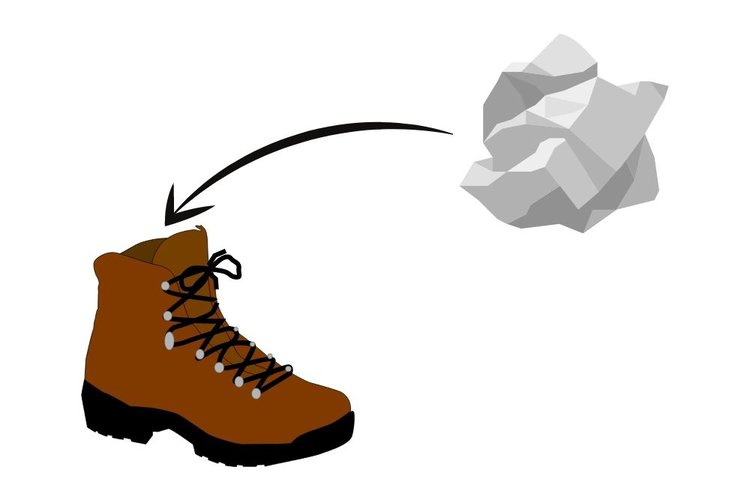
5. Wrap with a towel
- Bath towel measures 54 by 30 inches
- Made of 100% cotton for softness and tear-resistant strength
- Lightweight; quickly absorbs moisture for a cozy feel; attractive solid color
Last update on 2023-11-11 / Affiliate links / Images from Amazon Product Advertising API
Similar to stuffing the boots with newspapers or other drying materials, you can use an old towel to dry your boots too. Simply fold a towel and place it into the boots to wick out the moisture from the inside.
Then, use another towel to wrap the outside of the boots to wick out the moisture from the outside. This method should take around 10 hours to get the boots to a wearable condition—assuming you used them immediately after washing your boots.
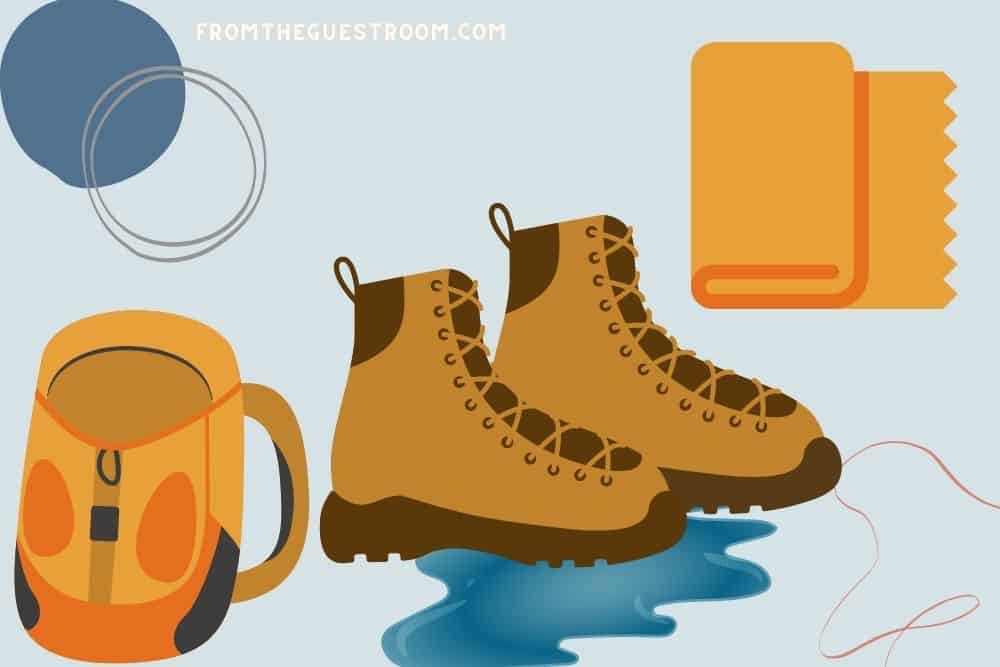
6. Sprinkle baby powder
When people use powder while making up, the aim is usually to soak up sweat and prevent it from tainting other delicate makeup. Well, you can also use powder to dry your hiking boots.
Firstly, smack your boots against each other and fling them as much as possible to get most of the moisture out. This will not only increase the effectiveness of the powder but also reduce the amount of powder that you need.
Sprinkle the powder on the wed areas of the boots and leave it overnight. The powder will soak up the moisture from the boots and cake so that you can easily knock them off.
Remove caked powder and sprinkle new one to fast track the process. For your boots to dry to wearable moisture level, you may have to leave them for up to 16 hours.
The biggest disadvantage of using powder to dry boots is that it makes the boots look messy. When you are done drying your boots, you have to put in work to get rid of the powder.
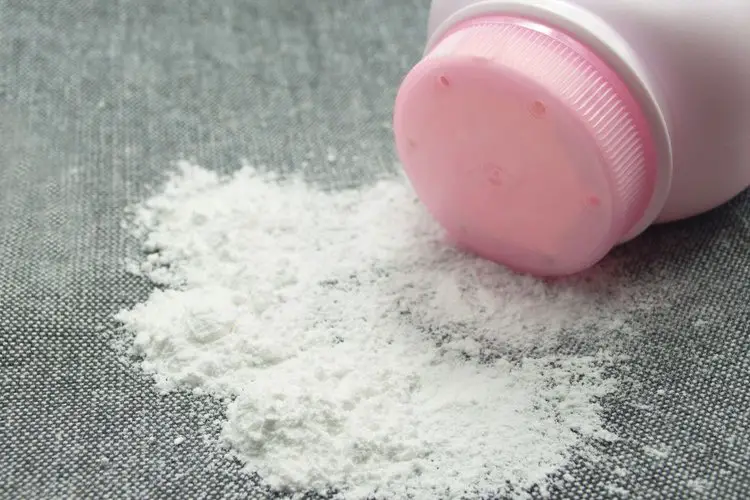
7. Use a hand warmer
No doubt, stuffing with a towel or newspaper—although effective—can be a slow drying process. A tad faster alternative will be replacing these stuffing materials with a hand warmer.
Simply remove the hand warmer from the package and shake them to activate the heat. This will take 15 to 30 minutes. Once the heat is activated, throw them into the boots.
Once the heat of the hand warmer starts to decline, expose them to air and shake again to get the heat back up. Hand warmers are single-use products but can get your boots dry in 8 to 10 hours.
The only downside is that it is an expensive process since you may have to use more than one for each pair of boots if you want to speed up the drying process.
- SAFE, NATURAL LONG-LASTING HEAT - Odorless, Disposable, Single-Use Item, Do Not Apply Directly to...
- TO ACTIVATE - Remove warmer from outer package, shake to activate. Warmer heats up in 15-30 minutes....
- MULTIPURPOSE WARMERS - Single use air-activated heat packs that provide everyday warmth and are...
Last update on 2023-11-11 / Affiliate links / Images from Amazon Product Advertising API
8. Hairdryer
The hairdryer technique and those that will follow cannot be achieved on the trail but are effective ways to dry your boots faster. With the hairdryer technique, you can adjust temperature and target wet areas to ensure even dryness.
- [Turbo 2200W Hair Dryer] Drying time is up to 5X faster for long and thick hair as compared to a...
- [Ionic and Ceramic] Thanks to modern technology, hair dries more quickly, softer and shiny. Heat...
- [Straightener Effect] Slim nozzles designed for salon use, provide hair quick straightening and...
Last update on 2023-11-10 / Affiliate links / Images from Amazon Product Advertising API
However, you need to be extremely careful when using the hairdryer and limit how frequently you use them. Also, never use them at the highest temperatures to avoid causing damage to your boots.
While using the hairdryer, make sure you push the pipe far into the toe areas because this area is harder to dry. With a hairdryer, you can achieve good dryness in about 2 hours.
Don’t try to get your boots to dry faster by increasing the temperature of the hairdryer or you may end up causing severe damage to your boots. The most interesting feature about drying your boots with the hairdryer is that they feel warm to the feet.
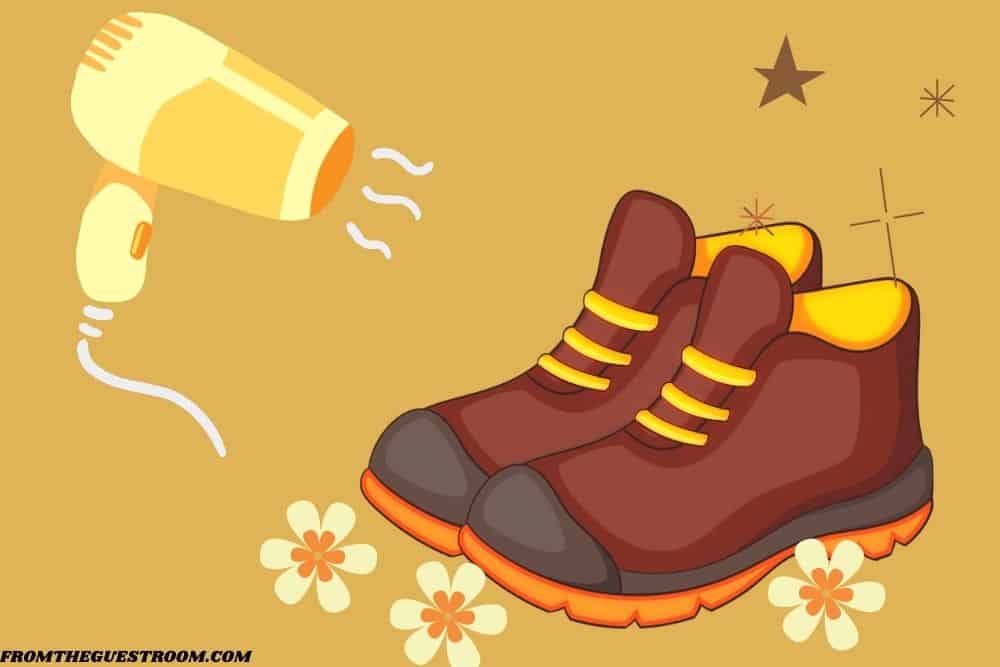
9. Use boot dryers
Everyone that owns a hiking boot knows how tough it is to dry them after they get wet. Therefore, it is not surprising that some people have taken the initiative to speed up the process by inventing boot dryers.
The boot dryer is designed to have a fan and heating coil inside which work simultaneously to get rid of the dampness from the boots. Some of the products allow you to dry two pairs of boots (4 separate feet) at once.
The good thing about using boot dryers is that they eliminate the risk posed by other drying techniques. For example, the fan blows warm air rather than hot air into the boots and the heater is autoregulated.
Most of the products come with a timer that shuts off the device after drying to avoid over-exposure. With a good boot dryer, your boots should be ready for a spin in just 2 hours.
- [Turbo 2200W Hair Dryer] Drying time is up to 5X faster for long and thick hair as compared to a...
- [Ionic and Ceramic] Thanks to modern technology, hair dries more quickly, softer and shiny. Heat...
- [Straightener Effect] Slim nozzles designed for salon use, provide hair quick straightening and...
Last update on 2023-11-10 / Affiliate links / Images from Amazon Product Advertising API
10. Place them in front of a fan
Placing your boots in front of a fan will help them to dry faster. You can compare this to what happens to you when you are all sweaty but sit in front of a fan.
The simple principle behind this is that the fan circulates air around the boots, pushing away saturated air and pushing forward unsaturated air—but we will spare you the entire physics involved in the process.
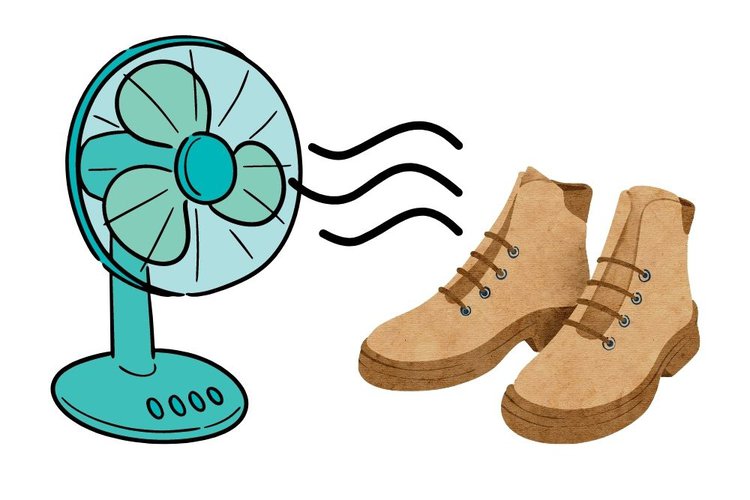
It is best to hand the boots in front of the fan in such a way that the air from the fan will hit both the interior and exterior at the same time. Place a towel on the floor directly under the boots to soak up the moisture that will drip from them.
This is a slow process that will likely last through the night or a minimum of 10 hours to achieve a decent level of dryness that will allow you to wear the boots.
- Small Fan for Table or Floor: The Honeywell Turbo Force Air Circulator Fan Has 3 Speeds & a 90...
- Feel the Power; Honeywell's TurboForce line of fans have an aerodynamic turbo design to maximize air...
- INCREASE YOUR COMFORT: Using fans for air circulation in your home can help increase your comfort,...
Last update on 2022-12-07 / Affiliate links / Images from Amazon Product Advertising API
11. Use a dryer
Since you can toss your hiking boots in a washing machine, many will be wondering if you can toss them into a dryer afterward.
If you have leather boots, this is a bad idea. The leather will dry rapidly leading to cracking. It is always best to check the manufacturer’s instructions to see what you can or cannot do with your boots.
However, if your boots are made from polyester, nylon, fabric, or cotton, you can give it a shot. Make sure the shoes are tied in a laundry bag or pillowcase to prevent the constant bumping of the boots on the walls of your dryer.
Using a dryer is a quick fix that can get your boots dry in under 1 hour. However, this is not something you should be doing all for obvious reasons.
Also, always set the dryer to the lowest temperature. High heat can still melt the glue used to hold the upper and the soles together.
Conclusion
It is important to mention that the weather also plays a part in how long it will take your boots to dry. The lower the relative humidity the faster your boots will dry and vice versa.
This means that if you take the same pair of boots washed using the same technique and subject them to the same type of drying technique, the one that is in an area with low humidity will dry faster than the one in an area with high humidity.
The reason is simple, the more humid the air is, the less amount of water it can take up. This also explains why it is a bad idea to attempt drying your hiking boots in the basement or closet because these areas often have high humidity.
The prevailing temperature will also affect how fast your boots will dry. For example, drying is faster during the summer compared to drying in the winter.
Therefore, while trying to dry your boots, it is important to always pay attention to the weather. Even though we gave you a tentative drying time frame, it can take significantly longer or shorter depending on the weather.
Unless you urgently need to wear your boots, we recommend keeping them in a well-aerated area and allowing them to dry. It takes longer but you would be sure that the material of your boots will not be harmed.

